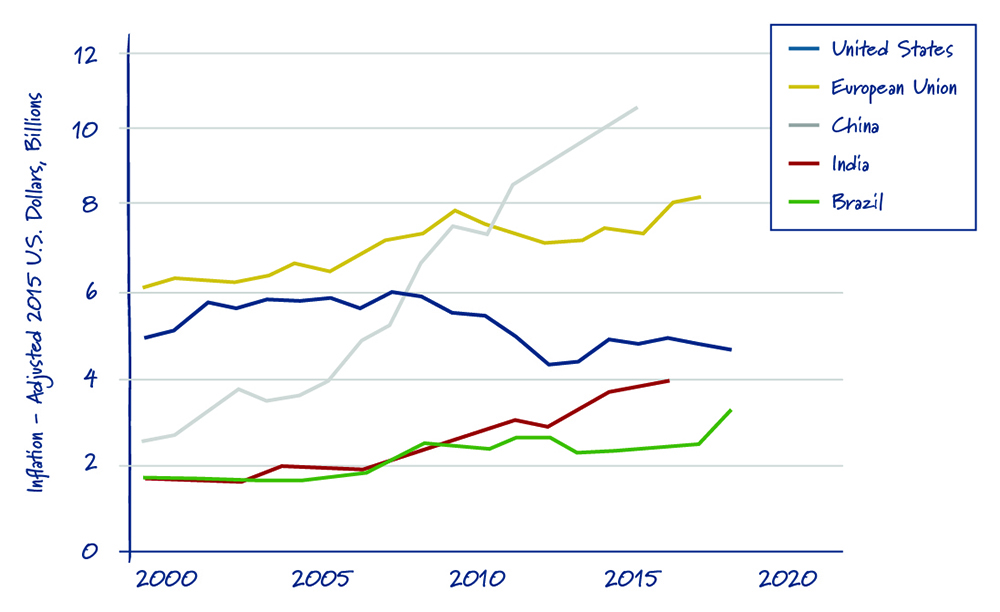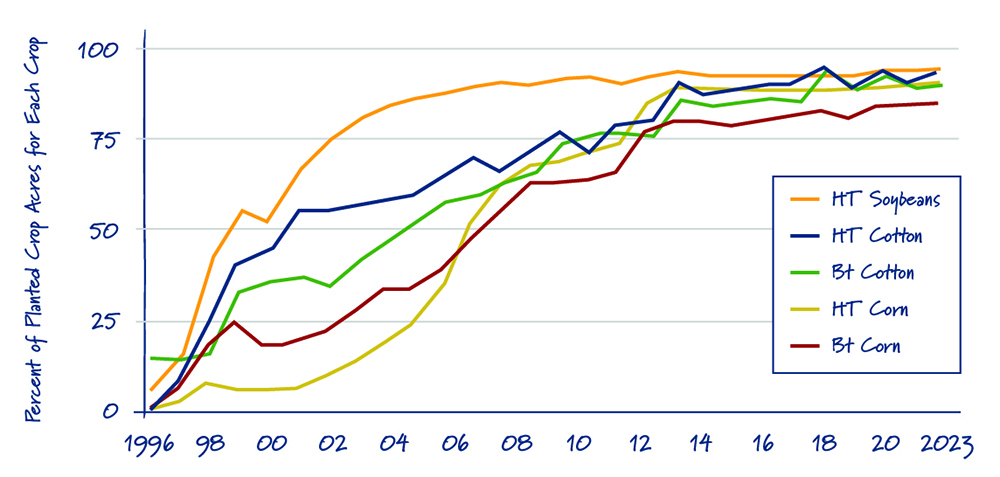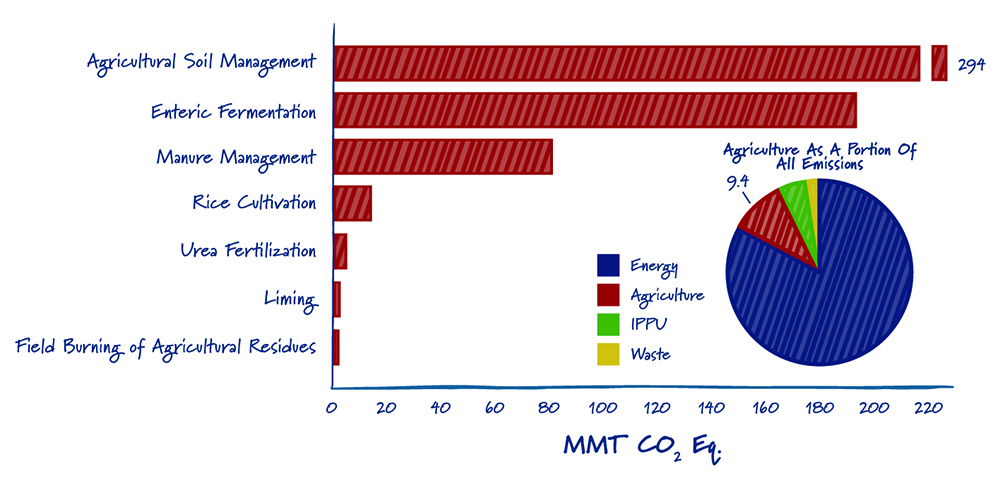Posted on November 28, 2023 by Jasmine Yu
The U.S. agricultural sector is due for innovations and new cutting-edge practices and technologies that can increase productivity and continue feeding the world, while lowering global emissions. Technology and innovative practices developed back in the mid-20th century are still being used today. During that period, American farmers and agriculture innovators addressed the rapid increase in global population and predicted food shortages. Some of these innovations include synthetic nitrogen fertilizers and crop breeding techniques that resulted in high-yielding crop varieties.
Much like the energy sector that ClearPath has historically focused on, the agriculture sector represents an opportunity for the U.S. to lead in developing new innovations and remaining a leader in the global marketplace. As American farmers and the 2.4 million farm workers continue feeding the world, they can also play a role in reducing global emissions without compromising any economic advantage. Today, the agriculture sector accounts for 9.4% of U.S. emissions, and with new innovations, the sector could see even lower emissions, with increased production.
This Agriculture Innovation 101 highlights successes in the industry, and policies that may help the U.S. continue producing, feeding the world and lowering emissions. Recommendations include:
The U.S. has historically been a global leader in agricultural innovation, resulting in the highly efficient production of agricultural products used for feed, fiber and fuel worldwide. This innovation has increased agricultural output and productivity (Figure 1). Specifically, between 1948 and 2011, soybean yields per acre doubled, and corn yields grew more than fourfold. Increased efficiency and productivity result from enhanced output creation and fewer inputs like water and labor. For instance, U.S. agriculture uses about 25 percent less farmland now than in 1948. As productivity increases, inflation-adjusted prices of agricultural commodities decrease, which benefits consumers.
Since 1990, advances in agricultural practices and technologies have increased the productivity of commodities due to improvements in crop yields, animal nutrition and breeding. For instance, cereal yields have increased by over 70 percent while requiring 10 percent less land use to fuel and feed the growing population. This also has the benefit of reducing emissions. The American Farm Bureau estimates agricultural emissions per capita in the U.S. have declined 20% since 1990 due to advancements in innovation.

Source: USDA-Economic Research Service
Total factor productivity (TFP) represents the total output per unit of aggregate input. It is a valuable productivity measurement because it considers all inputs' contributions. Therefore, TFP reflects long-term technological advancements in the agricultural sector, not just increasing input variations.
Research funded by the public and private sectors results in innovation that drives agricultural productivity, increasing revenues for farmers. The type of agricultural research supported by the public and private sectors varies. Therefore, it is essential to maintain support for agricultural innovation from both sectors. This is because research from the public and private sectors complement each other, ensuring cutting-edge solutions achieve widespread deployment.
In the U.S., public research and development (R&D) investments in agriculture rapidly increased from 1948 to the 1980s and peaked in 2002. However, by 2019, investments in real dollars had fallen by about one-third. Alternatively, over the past two decades, China’s public sector funding towards agriculture R&D has increased five times, while the U.S. has steadily declined, resulting in China becoming the largest funder of agriculture R&D since 2011 (Figure 2). By 2015, China was spending more than $10 billion annually on agriculture R&D, nearly double that of U.S. expenditures. Additionally, Brazil’s public agriculture R&D investments increased by about half and are currently around three-fourths of the U.S. investments.
China and Brazil’s spending increases are focused on enhancing Chinese and Brazilian commodity productivity, which could impact U.S. export competitiveness of domestic commodities. This is because China is a major importer of U.S. agricultural goods, and Brazil is a global competitor to the U.S. in corn and soybean markets. China announced in October 2023 its plans to approve 51 genetically modified crop varieties, with the expectation of planting them in 2024. This technology would allow Chinese corn and soybean producers to take wider advantage of seed technologies that have allowed U.S. farmers to produce more with less land. If that occurs, there is a high potential for reducing U.S. agricultural imports to China. U.S. leadership in seed technology is further described in the case study below.

Sources: USDA-ERS
Often, public sector-funded R&D focuses on “fundamental research” which is the pursuit of new scientific knowledge that may not have immediate commercial objectives. The private sector then invests to expand on the “fundamental research” to turn early-stage research into innovative commercial products. Initial public support for new high-risk and transformative R&D encourages future private development efforts by first de-risking the field. For instance, the private sector focuses mainly on R&D related to marketable goods and technologies, with a large share of investments going to the food manufacturing industry and farm machinery research. Alternatively, public sector research efforts may be applied to areas with large public benefits like lowering global emissions, natural resources and food safety. Additionally, public investment in agricultural research has resulted in economic benefits with an annual rate of return between 20 and 60 percent.
One example of the important role that innovation can play in advancing better yields for agriculture producers and reducing emissions includes the development of genetically engineered (GE) crops. Genetic engineering is a technique used since 1982, that alters genetic materials, or genes, of living cells and is the keystone to modern agricultural biotechnology. Genetic engineering has rapidly allowed plant breeders to develop improved crop varieties with targeted improvements of desired crop traits. This first genetically engineered plant approved for human consumption, a tomato (FlavrSavr tomato), was developed in the United States. Three years later, the USDA approved four releases of GE crops for field testing. By 1996, the commercial use of major GE crops began, primarily with traits that provide herbicide tolerance (HT) and insect resistance (Bt). Herbicides, or weed killers, are used to control weeds but can also harm crops. HT crops can survive even after the application of strong herbicides. Commercially available HT crops include corn, soybeans, cotton, canola, sugarbeets and alfalfa. Bt crops produce a toxin that is toxic to specific insects and protects the plant over its entire life. Commercially available Bt crops include corn and cotton. Over 90% of U.S. corn, upland cotton, and soybeans are produced using genetically engineered varieties (Figure 3).

Sources: USDA-ERS
Gene editing technology improved productivity by allowing farmers to plant corn crops more densely and earlier in the growing season, which expanded corn acreage to previously challenging regions. Improved crop varieties through genetic engineering have positively impacted global farm incomes. Globally, it was estimated that in 2020, farms that utilized GE crops experienced $18.8 billion in farm income gains or an average of $103 per hectare. Approximately 72% of farm income gains were derived from yield and production gains, while 28% came from cost savings. Global food crop yields from 1996 to 2012 have also increased by over 370 million tonnes, partially due to the use of GE crops. An equal increase in yield delivered by this technology would require 300 million additional acres of cropland.
In 2021, the U.S. agriculture sector emitted 598.1 million metric tons of carbon dioxide equivalent (MMT CO2eq), or 9.4% of total U.S. emissions (Figure 4). While that is a substantial amount, when put into context, the numbers could be higher. The U.S. population increased by 35% from 1990 to 2021, while U.S. agricultural emissions increased by just 7% to support the growing number of people. Much of that disparity is a result of agriculture innovation yielding higher returns for farmers and ranchers.
Although most focus on carbon dioxide when it comes to emissions, nitrous oxide is the largest source of agricultural sector emissions, accounting for 49.2% of agriculture emissions and 74.8% of total U.S. nitrous oxide emissions in 2021. Soil management activities such as fertilizer application or other practices that increase soil nitrogen availability produce around 94 percent of nitrous oxide emissions. The remaining 6 percent is derived from manure management and field burning of agricultural residues. Agricultural innovations and practices that optimize fertilizer management can reduce nitrous oxide emissions. Promising innovations include the use of enhanced efficiency fertilizers, which can control fertilizer release or inhibit nutrient loss, and microbial fertilizers that support plant growth and nutrient uptake.
Other emissions, such as methane, accounted for 46.5% of agricultural sector emissions and around one-third of total U.S. methane emissions in 2021, mainly from ruminates (cattle, sheep, goats, etc.) and manure management. Innovations that have emerged to reduce methane emissions include the use of anaerobic digesters, which reduce emissions from manure management, livestock breeding or engineering, and feed additives to reduce enteric methane emissions from ruminates.
Carbon dioxide emissions contributed 1.4% of agricultural emissions, primarily from urea fertilization and liming, which provides more nutrients to crops to enhance production. Agricultural lands and crops can also be utilized for carbon sequestration, such as with the development of enhanced root crops that store more carbon in their deep and expansive root systems and the use of biochar, a powdery-black stable carbon material that can be spread on agricultural lands to absorb emissions and improve crop productivity.

Sources: EPA U.S. Greenhouse Gas Emissions and Sinks 1990-2021
IPPU= Industrial Processes and Product Use
To meet global emissions reduction goals, public and private sector stakeholders are prioritizing the development and deployment of solutions that increase domestic capabilities while reducing agricultural emissions. Adoption of emissions-reducing, on-farm solutions will depend on scalability to various geographic regions, equal or improved productivity when implemented, producer buy-in, and international market signals.
